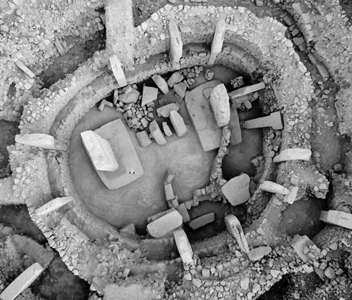
Göbekli Tepe "potbellied hill", (partial excavation)


Göbekli Tepe ("Potbelly Hill"), is a Pre-Pottery Neolithic (PPN) archaeological site in Southeastern Anatolia Region of Turkey. First archaeological excavations by Prof. Klaus Schmidt began at the site in 1995. The ruins thus far exposed consists of a series of circular and oval-shaped structures with diameters up to 30m. Recent georadar (GPR) surveys put the number of these structures at 23, of which only six have been unearthed by excavation. The remaining unexcavated circles have been identified via magnetic and georadar surveys.
The excavations and surveys indicate that roughly 11,500 years ago Göbekli Tepe was an important place of gathering, and that its monumental structures were not erected for domestic use, but for ritual or religious purposes. Among these, Temple D is the most well-preserved and largest structure dated to c. 9500-8500 BCE. T-shaped pillars with a height of 6m and mass of up to 30 tonnes can be found in the center of the temple, surrounded by a ring of 12 other pillars, which art the world's oldest known megaliths. The pillars are covered with depictions of arms, hands and fox reliefs. The T-pillars can undoubtedly be considered as human or humanoid deity symbols. Various other animal reliefs such as boar, ox, donkey, antelope, crane, snake, duck, felines can be found on the pillars; snake and fox reliefs dominate this selection.
Göbekli Tepe first used at the dawn of the Neolithic period, marks the oldest permanent human settlement anywhere in the world. The tell also includes many smaller rectangular buildings, and stone-cut cisterns from the Neolithic, as well as some traces of activity from later periods. The site vicintiy, located far from known sources of water, has not so far produced evidence of agricultural cultivation.
Elevation is 760 meters (2,490 feet) above sea level
Material: Monolithic 'T-shaped" stones columns, walls of small mortaless stones, roof unknown. Current archaeological thinking is that the T-pilllars supported wooden roofs in which the the entrances to the structures were placed.
Data for CG model:
1. Schmidt, Klaus, 2010: "Göbekli Tepe—the Stone Age Sanctuaries: New results of ongoing excavations with a special focus on sculptures and high reliefs," Documenta Praehistorica XXXVII (2010), 239–256:
https://web.archive.org/web/20120131114925/http://arheologija.ff.uni-lj.si/documenta/authors37/37_21.pdf
2. Hancock, Graham, 2015. Magicians of the Gods, Forgotten Wisdom of Earth's Lost Civilization, Thomas Dunne Books, NewYork, N.Y.
3. Göbekli Tepe Unlocked | Exploring the Site and Pillar 43 Close-Up | Megalithomania: https://www.youtube.com/watch?v=KMX-pDOUlw0
4. .Karahan Tepe | Civilization of the Ancients | Andrew Collins | Origins Conference: https://www.youtube.com/watch?v=2AzZFZubIDE&t=1496s








